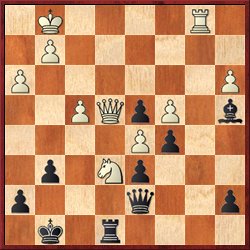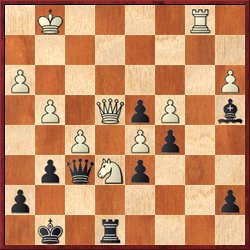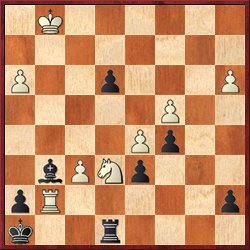So I was thinking that I really didn’t want to write this blog entry. Nobody wants to read my moaning and groaning about how badly I’m playing, right? Losing is boring. People only care about the winners.But then it occurred to me that people who really like my blog won’t care. In fact, reading the blog of somebody who always wins and is always telling you how great they are can get kind of boring, too. So I will say unapologetically: So far the US Open has been an unmitigated disaster for me. I currently stand at 2-3. All four of my games (there was one half-point bye) have been against lower-rated players, so I have absolutely no excuse.
Now, having said there is no excuse, let me tell you my excuses. I have barely studied chess in the last month, because all of my attention has been on the book that I am finishing (deadline in two weeks!). With such a lack of practice, you can’t expect to play well. My second excuse is that I have not been getting a lot of sleep. One thing I hadn’t anticipated when I went on this trip with Cailen and Thadeus is that teenage boys like to stay up late — midnight, 1 am — but my 50-year-old body is set for waking up around 7. So I’ve been going on about 6 hours of sleep per night, although this morning I forced myself to stay in bed until almost 8.
The other thing — more of a curiosity than a complaint — is that Cailen talks in his sleep. It seems to happen when he wakes up just a little bit, but not all the way. Half of what he says is gibberish, and half is English. The first night, for example, he stirred and shifted around and then blurted out: “Hunt. Hunt. Over here. Kovyhrhr.” The last word ended with sort of a sighing, whimpering exhalation, like a horse whinnying. Last night he spoke several times, but my favorite was when he said, “Cret. Coo!” (The latter word was pronounced with a short “oo”, as in “cook,” not a long “oo” as in “cool.”) The funny thing about his gibberish is that it comes out so naturally and with such conviction. He really said, “Cret. Coo!” with a great deal of satisfaction, as if he had just gotten a nice plate full of cret, and that was coo with him.
Okay, so let’s go back to the chess. Thadeus is also 2-3 and was really disappointed yesterday. He isn’t used to losing so much. In one game he was completely winning and then walked into a three-move combination and lost his queen. I think he and Cailen have been both a little bit surprised by the level and intensity of the opposition. They’re used to getting a break and playing some 1400 and 1500 players, but it hasn’t happened in this tournament. As for Cailen, he started out 1-3 and then decided to pay $100 and re-enter in the 4-day section. So far his score is 1½-1½, so he has already improved a little bit.
I don’t really know yet what is going on among the leaders. There aren’t a whole lot of GMs at the tournament, maybe 10 or so. I have been impressed with Daniel Naroditsky’s games. Although I don’t know what his score is, he has always been near the top boards, and every time I’ve looked at his games, he has always been putting pressure on his opponent. Thadeus, I think, commented, “And he plays on the edge.” He plays sharply but without losing control, and that is a very impressive feat.
Also I was impressed with an endgame by Tim Taylor where he had a queen and pawn against a rook and two pawns. I thought his opponent had an ironclad fortress, but Taylor broke through somehow and forced the rook to move away from the fortress, and then he hunted it down all the way across the board and got one of those typical positions where the rook has 14 moves but every one of them walks into a fork eventually. I hope I can find the game score on MonRoi to see how he did it. (I’m sure that his opponent must have been in time trouble by the end of the 99-move battle, so that may have affected the result.) [Correction: I just went to the MonRoi website and saw that the result of Studen-Taylor was a draw, not a win for Taylor. So my initial impression that the game was a dead draw was correct.]
As for my games, they have actually been good, hard fought games without obvious blunders. I’ve just been making poor decisions and getting into time trouble, which leads to more poor decisions. But also, my opponents have been playing very well. My most recent game was against Alexandra Botez, a high-school aged girl who lives in Oregon but was born in Romania. Although I try not to pay attention to ratings, something happened that really threw me off. She has a FIDE rating around 2000 and a USCF rating of 1885, but I misread her rating on the wall chart and thought she was rated 1585! So here is this expert-strength player (who is, by the way, young, attractive and female) banging out one excellent move after another, and I’m wondering, “When is she going to start playing like a 1585 player?”
By move 30 I was totally busted, and could barely even move my pieces, but then an amazing thing happened.
Black to move.
Hardly any of my pieces can move. Take a look especially at that bishop, stranded at the edge of the board. I played 28. … Qe7, hoping maybe to play … Rc8, … Be8, and … Bf7. But this is a pretty slow plan, and Alexandra stuck right away with 29. f5. In retrospect this may have been a bit of a mistake, but the flaw is very well hidden. Now I played 29. … Qf6, hoping for 30. fg Qxg6! With queens off the board, Black’s bishop on a4 suddenly transforms from a bystander to a very powerful piece, and the pawn at d4 can start to run. She instead played 30. g4, leading to this position:
Black to move.
Here I played 30. … Qe5! I was in very serious time trouble here, with probably about 5 minutes left for 10 moves, and so I couldn’t work out the tactics all the way (and I still haven’t). But I think that after 31. Qxe5 de 32. Nxc5 White would be in grave, grave trouble. The d-pawn is very hard to stop, and she might have to sac a piece for it. At this point she had lots and lots of time left — about 50 minutes — but she reached the same conclusion I did, and retreated 31. Qd3. Now I continued 31. … gf 32. gf and faced my next decision, which should have been easy.
Black to move.
Here my instinct was to play 32. … Kf7, and I should have gone with my instinct! If White plays the obvious 33. Rb7+ Kf6 she is losing! Black’s rook and bishop all get into the attack, while Black’s king is miraculously relatively safe.
Do you want to know why I didn’t play that move? It’s because I got greedy. After 32. … Kf7 I saw that she could play 33. Ng5+ and then I didn’t see anything better than 33. … Kg8 34. Ne3 with a repetition of position. Believe it or not, only four moves after being totally busted, I was now turning up my nose at the possibility of a draw! For shame! I was perhaps influenced here by the fact that I thought her rating was 1585, rather than FIDE 2000.
In fact, it is very unlikely that she would have played 33. Ng5+. In the post mortem I couldn’t even get her to look at the move. “It just looks so terrible,” she said. Having worked hard to get her knight to e6, she was psychologically unable to consider moving it. But every other variation we looked at was either lost or very problematic for White. So for psychological reasons, if I had played 32. … Kf7 I probably would have won the game. Amazing! What an unbelievable turnaround!
But instead I played 32. … Qe3+??, a move that absolutely makes no sense. I shouldn’t even be considering this move, because without even doing any analysis it is clear that Black cannot possibly win — whereas in the other line, Black has very definite winning chances. However, it’s worse than that. 32. … Qe3+ loses by force after 33. Qxe3 de 34. Rb7 Bc2 35. f6 Bg6 (all forced) 36. Rg7+! Kh8.
White to move.
Here I saw her winning combination, but because I was still under the impression that she was a 1585 player (albeit a very underrated one) I still had very faint hopes that she might miss it. Alas, no. She didn’t miss anything this game, except that … Qf6-e5 maneuver on moves 29 and 30, which was very easy to miss.
37. Rxg6! hg 38. f7 …
And here I should have resigned, but I played on another 10 moves because I thought she was a class C player. Sorry, Alexandra! I didn’t mean to disrespect you!
Well, what can you do? The main thing I need to do is not get into time trouble, so debacles like my 32nd move won’t happen. I hereby pledge in public to make my first 10 moves today in 20 minutes, and my second 10 moves in 25 minutes, unless a situation arises that is clearly the critical moment of the game. If I can adhere to this pledge, then I will have 1:15 left for my last 20 moves, and that should be enough to play the middlegame reasonably well.
Cret? Coo!







{ 2 comments… read them below or add one }
It’s good to read a blog of a decent player who struggles from time to time. None of that “I’m 1400 so I’m going to do the MDLM Seven Circles in 3 weeks!” crud.
The US Open brings many class players out of the woodwork, and I’ve made it a habit to check the rating but ignore it if they are a youth. In the 2008 Open (Dallas) I played a guy who’s MSA had no activity for the 2 years prior…he was 140 points higher and made the mistake of playing my rating instead of the board. He was quite frustrated after his loss.
Hi Dana,
Thanks for sharing this game.
To add to your excuses maybe you can take a look here:
http://web.ncf.ca/bw998/CanadianChess/History/CanadianChessBiographiesB.html#BOTEZ
Also like a side note, she is 14 and is born in Dallas, Texas from Romanian parents, and lived in Canada between 3 and 13 (that is why she plays under Canadian flag).